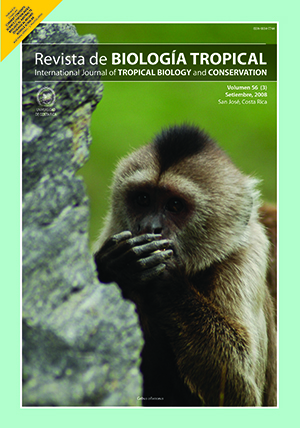Abstract
During October and November 1998 (rainy season), and December, February and March 1999 (dry season), larvae distribution of Petrolisthes armatus and associated decapods were sampled in three different sites at the Punta Morales peninsula, Gulf of Nicoya, Costa Rica. A total of 6014 decapod larvae were collected, and 73 belonged to the genus Petrolisthes spp. No significant total larval density differences were found between seasons (p>0.05); but there was a greater density of P. armatus and other decapod larvae (p>0.05) during the dry season. In addition, no significant variations on temperature and oxygen concentration were observed. P. armatus larval abundance was higher during low tide, in contrast with other decapod larvae. Significant differences among sites were found for other decapod larvae, but not for P. armatus. The only parameter that varied significantly between seasons was salinity and results demonstrate that this factor regulates temporal concentration of larvae. Moreover, flow-tide oscillations were the most important spatial factor in lar-val dynamics. We propose this mechanism: P. armatus liberates larvae during high tide; these larvae leave the coastal area during low tide and return to the rocky intertidal ecosystem during high tide, when they are ready to settle as megalopa (pre-juvenile stage). Parallel laboratory observations showed higher survival rates at lower salinities (15 ups against 35 ups) and that the duration of the period from zoea I to megalopa was, in average, 19 days.
##plugins.facebook.comentarios##

This work is licensed under a Creative Commons Attribution 4.0 International License.
Copyright (c) 2009 Revista de Biología Tropical






